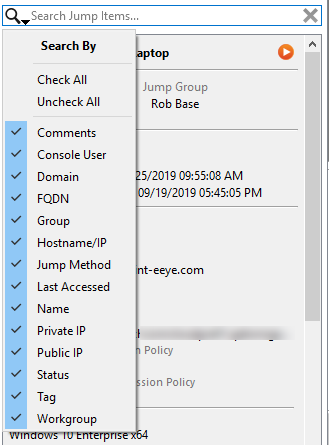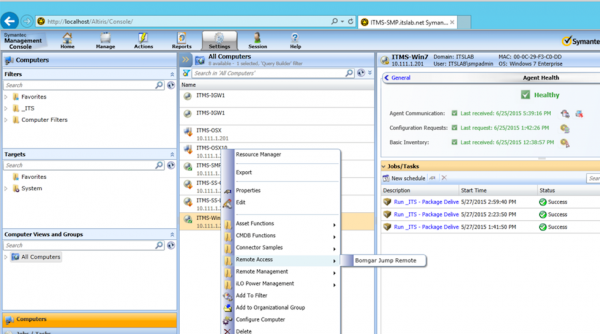

- Bomgar jump client not connecting update#
- Bomgar jump client not connecting upgrade#
- Bomgar jump client not connecting software#
- Bomgar jump client not connecting password#
- Bomgar jump client not connecting Offline#
Jump Clients allow for one of two modes of behavior, active or passive.
Bomgar jump client not connecting password#
When sending a WOL packet, the user has an advanced option to provide a password for WOL environments that require a secure WOL password. The default gateway information of the Jump Client is used to determine if other Jump Clients reside on the same network. WOL must be enabled on the target computer and its network for this function to work. Once a WOL is attempted, the option becomes unavailable for 30 seconds before a subsequent attempt can be made. Once awake, Jump Clients always connect to the B Series Appliance on port 80 or 443 outbound.Īllow users to attempt to wake up Jump Clients provides a way to wake up a selected Jump Client by broadcasting Wake-on-LAN (WOL) packets through another Jump Client on the same network. Ensure that firewall settings allow inbound traffic on this port for your hosts with passive Jump Clients. The Passive Jump Client Port specifies which port a passive Jump Client uses to listen for a "wake up" command from the B Series Appliance. Set the default connection type of the Jump Client to be deployed.
Bomgar jump client not connecting Offline#
If the Jump Client cannot contact the B Series Appliance at the time it is uninstalled, the affected item remains in its offline state. Depending on dropdown option selected, the deleted item can either be marked as uninstalled and kept in the list or actually be removed from the Jump Items list in the access console. Uninstalled Jump Client Behavior determines how a Jump Client deleted by an end user is handled by the access console.

Only an invitation by the user who originated the session can allow for a second user to access the session. If disallowed, only one user can Jump to a Jump Client at a time. If allowed, multiple users can gain access to the same Jump Client without an invitation to join an active session by another user. You can set Jump Clients to allow or disallow simultaneous Jumps from the Jump > Jump Items > Jump Settings section.

To allow you to identify lost Jump Clients before they are automatically deleted, this field should be set to a smaller number than the deletion field above. It is labeled as lost only for identification purposes, so that an administrator can diagnose the reason for the lost connection and take action to correct the situation. No specific action is taken on the Jump Client at this time. If a Jump Client goes offline and does not reconnect to the B Series Appliance for the number of days specified by the Number of days before Jump Clients that have not connected are automatically deleted setting, it is labeled as lost in the access console. If this setting is changed after the Jump Client loses connection with the B Series Appliance, it uninstalls itself at the previously configured time. This setting is shared with the Jump Client during normal operation so that even if it cannot communicate with the site, it uninstalls itself at the configured time. If a Jump Client goes offline and does not reconnect to the B Series Appliance for the number of days specified by the Number of days before Jump Clients that have not connected are automatically deleted setting, it is automatically uninstalled from the target computer and is removed from the Jump interface of the access console. Set whether the default Jump Client connection type should be active or passive.

Set the global connection rate for disconnected Jump Clients to try to reconnect. Failure to do so may cause a majority of your existing Jump Clients to appear offline.
Bomgar jump client not connecting software#
When upgrading to a newly built site software package, verify that all certificate stores are managed appropriately and are up-to-date prior to upgrading to a new BeyondTrust version. Note that if you have a large number of Jump Clients deployed, you may need to limit this number to regulate the amount of bandwidth consumed.
Bomgar jump client not connecting upgrade#
You may regulate the bandwidth used during upgrades by setting Maximum bandwidth of concurrent Jump Client upgrades.Īlso set the maximum number of Jump Clients to upgrade at the same time. The more active Jump Clients you have deployed, the fewer the statistics and the longer the interval may need to be. Managing which statistics are viewed and how often can help to regulate the amount of bandwidth used.
Bomgar jump client not connecting update#
The Active Jump Client Statistics Update Interval determines how often these statistics are updated. These statistics are displayed in the access console and include CPU, console user, disk usage, a thumbnail of the remote screen, and uptime. An administrator can choose which statistics to view for all Jump Clients on a site-wide basis.


 0 kommentar(er)
0 kommentar(er)
